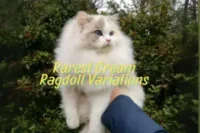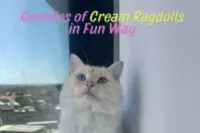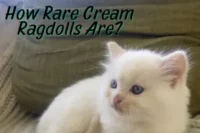Lilac Bicolor Ragdoll: What Makes Them Unique?
Published: 6 Sep 2025
Purr-haps one of the most enchanting sights in the cat world is a Lilac Bicolor Ragdoll. With their soft pastel coats, striking blue eyes and sweet-as-sugar personalities, these Lilac Ragdoll gentle fluffballs have a way of melting hearts the moment they walk into a room.
We have been lucky enough to share our home with Ragdolls and trust us once you have cuddled a lilac beauty, there’s no way going back. The Lilac Bicolor Ragdoll isn’t just a pretty face; it’s a rare color variation that brings an extra dose of magic to an already loving and laid back breed.
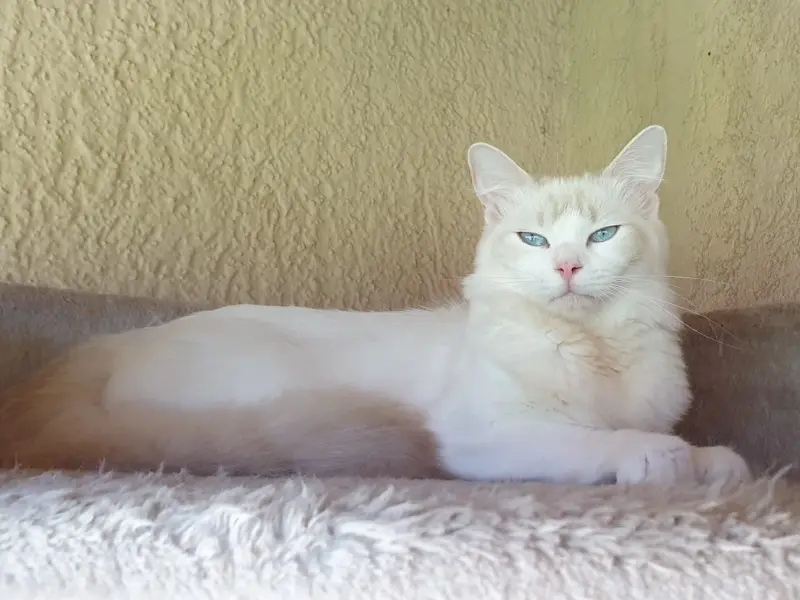
In this guide, we will walk you through everything we know and love about Lilac Bicolor Ragdolls from their unique coat patterns to their easygoing personalities and what it’s like living with one of these gentle giants. If you have ever wondered whether a Lilac Bicolor Ragdoll might be the purr-fect match for your family then you are in the right place.
What is a Lilac Bicolor Ragdoll?
When we first heard the term Lilac Bicolor Ragdoll, it sounded almost like something out of a fairy tale and honestly, that’s not far from the truth. These cats look like they have been brushed with soft pastel colors, giving them an angelic charm.
A Lilac Ragdoll isn’t actually purple (we get asked this a lot!). “Lilac” is a cat breeder’s term for a very light and frosty version of chocolate brown. Imagine a warm gray coat with a soft pinkish glow, that’s the lilac in the cat world.
The “Bicolor” pattern means their coat has a mix of white and lilac shading in specific places. The most recognizable feature is a sweet white inverted “V” marking on their face, paired with a snowy white belly, chest and legs. Their ears, tail and parts of their back are touched with the lilac color which create a purr-fect balance.
How the Bicolour Pattern Looks
One of the things we adore most about Lilac Ragdolls Bicolor is their stunning, one-of-a-kind coat. If you have ever seen one up close, you know how their markings make them look like little works of art. Here’s a closer look at what makes their pattern so special:
- The Inverted “V”: Right on their face, you will spot a soft white marking shaped like an upside down “V.” It stretches from their forehead down over the nose and gives them that sweet and angelic expression that melts our hearts every time.
- Snowy Whites: Their chest, tummy and all four legs are pure white like they are wearing cozy socks and a fluffy bib. It makes them look extra cuddly and yes, we have been known to bury our faces in that soft belly fluff.
- Lilac Highlights: Their ears, tail and parts of their back are shaded in the delicate lilac-gray tone. It’s a subtle color that makes them look almost pastel, especially when the sunlight catches their fur.
- Pinkish Touches: Their paw pads and little nose are a soft pinkish gray which gives them an extra touch of sweetness. We think it looks like they are dipped in rose dust.
- Deep Blue Eyes: Of course, no Ragdoll look is complete without those iconic sapphire blue eyes. On a lilac bicolor, the contrast between the pale coat and the brilliant eyes is absolutely breathtaking.
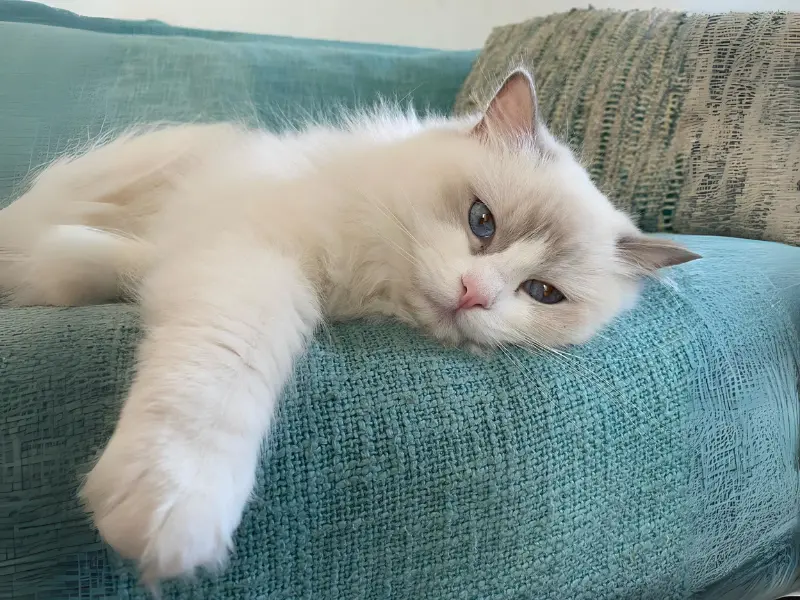
What’s fun is that no two Lilac Bicolor Ragdolls ever look exactly the same. Some have a more pronounced lilac shade while others look extra snowy and light. Each one feels like nature’s own fluffy masterpiece.
Personality Traits of Lilac Bicolor Ragdolls
If there’s one thing we have learned from living with Ragdolls, it’s that their personalities are just as beautiful as their coats. The Lilac Bicolor Ragdoll is no exception. These gentle giants are known for their sweet, calm nature and their endless love for cuddles. 💙
Gentle and Affectionate Companions
Our bicolor lilac ragdoll loves to be near us, whether we’re working, relaxing or just making a cup of tea. They follow us from room to room often flopping right at our feet or curling up in our laps. We like to call them our “living shadows,” because they are always close by but never demanding.
The Famous Ragdoll “Flop”
True to the Ragdoll breed, Lilac Bicolors often go completely limp when we pick them up. It’s like holding a big soft plush toy that trusts you completely. This easygoing behavior makes them wonderful companions for families, kids and even other pets.
Playful, But Not Overactive
They enjoy playtime with feather toys, tunnels and the occasional game of chase but they are not highly energetic cats. A Lilac Bicolor Ragdoll is just as happy lounging in a sunny spot as they are batting at a toy. They have a calm and balanced temperament that fits beautifully into a cozy home life.
Social Butterflies
One of our favorite things about Lilac Bicolour Ragdolls is how welcoming they are to new people. Guests often comment on how quickly our Ragdolls come up to say hello, as if they have known them forever. Lilac Bicolors especially seem to thrive on human company. They want to be part of the family’s actions and not hidden away.
Are They Different From Other Ragdolls?
We often get asked if Lilac Bicolor Ragdolls act differently because of their rare coloring. The answer is no, their personalities are just as gentle and affectionate as any other Ragdoll. The only difference is the coat color and pattern which makes them look extra special.
Lilac Bicolor Ragdoll vs Other Ragdoll Colors
One of the most fascinating things about Ragdolls is the variety of colors and patterns they come in. Each variation has its own charm but the Lilac Bicolor truly stands out for its soft and dreamy tones. When we compare them to other popular Ragdoll colors, the lilac feels almost like a pastel painting brought to life.
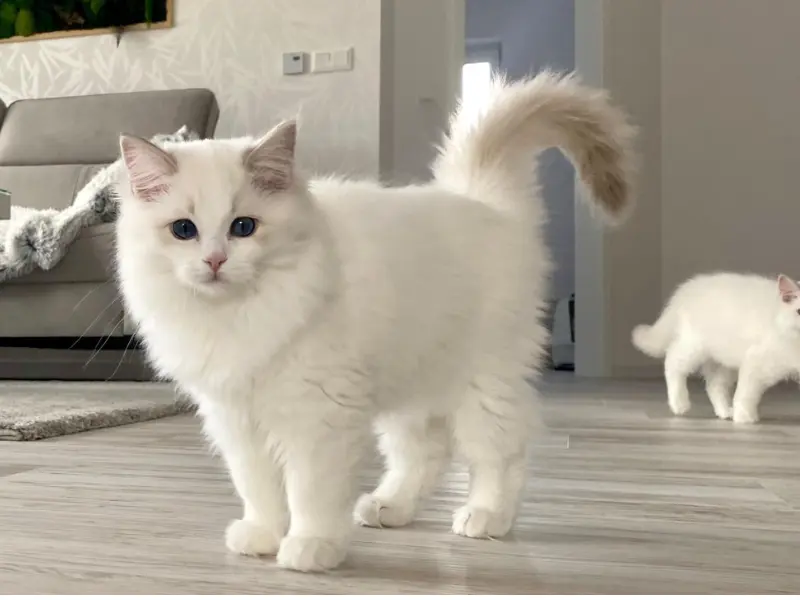
Lilac vs Seal Bicolor Ragdoll
- Seal Bicolor Ragdolls have deep, rich chocolatey brown points (ears, tail, parts of the face). Their contrast against the white coat is bold and striking.
- Lilac Bicolor Ragdolls, on the other hand, have the palest and softest tones. A diluted version of chocolate that looks silvery-gray with a pinkish hue.
- If Seal feels warm and dramatic, Lilac feels light, airy and angelic.
Lilac vs Blue Bicolor Ragdoll
- Blue Bicolor Ragdolls carry a cool gray color that’s darker and stronger than lilac. They often look sleek and elegant.
- Lilac Bicolors are even lighter with a more pastel look. Their coats seem softer and almost frosted in comparison.
- Both are stunning but the lilac is rarer and has that delicate, “dream cat” vibe.
Lilac vs Chocolate Bicolor Ragdoll
- Chocolate Bicolor Ragdolls are warmer in tone with milk chocolate shading. They are less common than seals or blue but not as rare as lilac.
- Lilac Bicolors are the diluted form of chocolate which makes them appear frosty and pastel instead of rich and warm.
- We often say lilacs look like chocolates that have been dusted with soft powdered sugar.
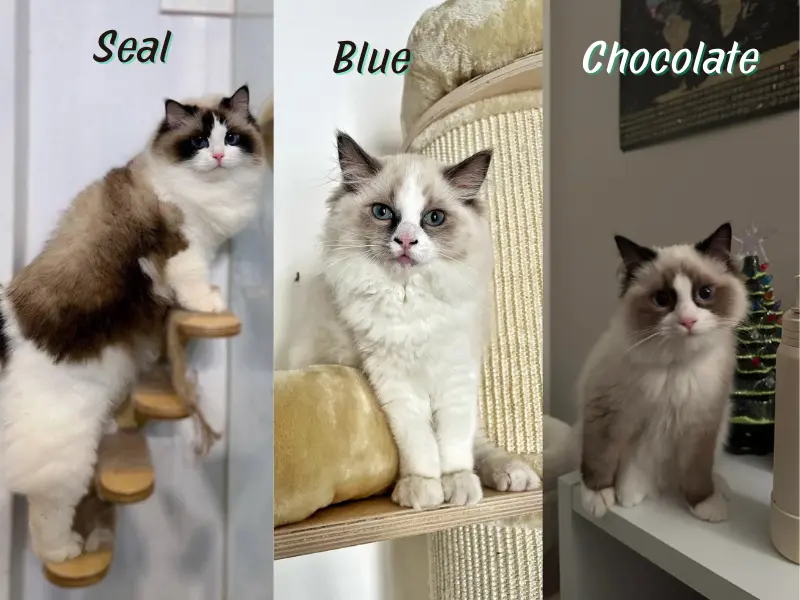
Why Lilacs Feel So Unique
While all Ragdolls share that sweet and gentle personality, lilacs truly shine because of their rarity and their soft pastel look. Many people fall in love at first sight simply because they are so different from the darker, more common Ragdoll colors. They’re the kind of cats that make guests stop and say, “Wow, I’ve never seen a cat like that before!”
Grooming and Care Tips for Lilac Bicolor Ragdolls
Living with a Lilac Bicolor Ragdoll means living with a cloud of silky fluff and we wouldn’t have it any other way! Their coats may look glamorous but the good news is they’re surprisingly easy to care for as compared to some long haired breeds. With a little routine grooming and proper care, your lilac cuddle buddy will stay healthy, happy and as stunning as ever.
Coat Care and Brushing
One thing we love about Ragdolls is that their fur doesn’t mat as easily as other long haired cats. Still, we have found that a quick brush a few times a week works wonders. It keeps their coats shiny, reduces shedding around the house and gives us a sweet bonding moment.
- Use a stainless steel comb or slicker brush for best results.
- Focus on areas like the belly and underarms where tangles can sneak in.
- Brushing doubles as cuddle time and most Ragdolls actually enjoy it!
Bathing (Optional)
We rarely bathe our Ragdolls unless they get into something messy. Their coats naturally stay clean and soft. If you do need to give a bath:
- Use a cat-safe shampoo only.
- Make sure they are fully dry afterward to avoid chills.
Eye and Ear Care
Those sparkling blue eyes can sometimes water a little. We gently wipe them with a damp cloth when needed. Their ears should be checked weekly and if they look dirty, a cotton pad with a bit of vet-approved ear cleaner does the trick.
Nail Trimming
Like all cats, Lilac Bicolor Ragdolls benefit from regular nail trims. We trim every 2–3 weeks and keep scratching posts around the house. (Our sofas say thank you!)
Diet and Nutrition
We have noticed that what our Ragdolls eat really shows in their coats. High quality cat food with plenty of protein and omega fatty acids keeps their fur silky and their bodies healthy. Always make sure fresh water is available too.
Common Health Considerations
Ragdolls, including lilac bicolors, are generally healthy cats. But like the rest of the breed, they can be prone to a heart condition called hypertrophic cardiomyopathy (HCM). Don’t let the name scare you because regular vet checkups and responsible breeding practices help in keeping this risk low. We also watch their weight closely, since Ragdolls love lounging as much as they love playing.
With just a little love and care, your Lilac Bicolor will shine like the soft pastel star they are. And honestly? Grooming sessions often turn into extra cuddle sessions which is our favorite part.
Lilac Bicolor Ragdoll Kittens
Oh, there’s nothing quite like welcoming a Lilac Bicolor Ragdoll kitten into your home. These tiny fluffballs are bundles of sweetness with their big blue eyes and soft coats that grow fluffier by the week. Raising them is such a rewarding experience that we still remember the first time one of our lilac kittens flopped into our arms like a little ragdoll toy!
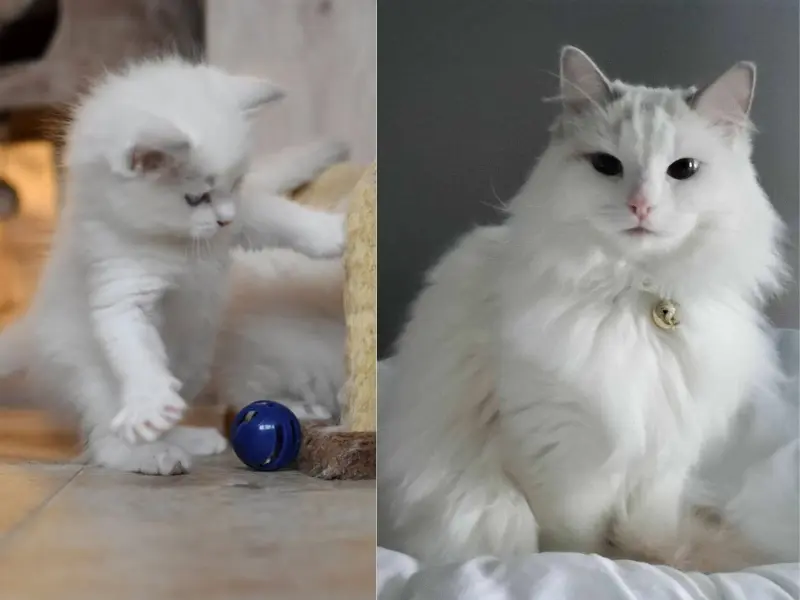
How Lilac Bicolor Kittens Look at Birth
When lilac bicolor kittens are born, their coats are almost completely white. It’s only as they grow that their lilac shading starts to appear. This makes watching them grow extra exciting because their markings slowly reveal themselves over time.
- At a few weeks old, you may notice faint lilac tones around the ears and tail.
- By a few months, the soft “V” mask on their face and the pastel shading on their back become more noticeable.
- Their blue eyes stay with them forever and is one of the most magical traits of the Ragdoll breed.
Growing Into Their Full Colors
Ragdolls are slow to mature. We have noticed that it can take up to 3–4 years for Lilac Bicolour Ragdolls to show full coat color and size. That means your little lilac fluffball keeps changing and surprising you for years, it’s like watching them grow into a work of art.
Socializing Your Lilac Kitten
These kittens are naturally affectionate but early socialization helps them grow into confident adults. We spend plenty of time cuddling, playing and letting them explore safe spaces in the house. They thrive on gentle handling and are usually quick to trust everyone in the family.
- Provide cozy spots where they feel safe.
- Offer feather toys and tunnels to keep their curious minds busy.
- Invite gentle interactions with friends and family so they get used to different people.
Finding a Reputable Breeder
Because Lilac Bicolor Ragdolls are rare, it’s important to choose a breeder who cares about the cats’ health and happiness. When we looked for our lilac babies, here are the things we paid attention to:
- Health testing: Reputable breeders screen for conditions like HCM.
- Socialization: Kittens should be raised in a loving home environment not cages.
- Transparency: Good breeders happily share medical records, answer questions and let you meet the kittens (or show updates if far away).
- Avoid red flags: If a breeder can’t provide paperwork, rushes the process or has too many litters at once, it’s best to walk away.
Bringing home a lilac bicolor kitten is a magical experience but it’s also a long-term commitment. With the right care and plenty of love, your kitten will grow into a gentle giant who fills your home with purrs and cuddles.
How Much Does a Lilac Bicolor Ragdoll Cost?
One of the first questions we had when we fell in love with Lilac Bicolor Ragdolls was, “How much does one of these rare beauties cost?” Since they are one of the rarer Ragdoll colors and their price can be a little higher than the more common blue or seal point ragdoll varieties. But every purr and cuddle is worth it!
Average Price Range
On average, a Lilac Bicolor Ragdoll kitten can cost anywhere from $1,200 to $3,000 USD depending on several factors. Kittens that come from champion bloodlines or are meant for showing and breeding often sit at the higher end of this range.
Factors That Affect the Price
When we were searching for our lilac fluffballs, we noticed a few key things that influenced the cost:
- Rarity of the Color: Lilac is one of the rarest Ragdoll shades which naturally makes kittens more expensive.
- Breeder Reputation: Trusted and ethical breeders who test their cat’s health regularly may charge more but you’re paying for peace of mind and a well cared kitten.
- Pet vs. Show Quality: “Pet-quality” kittens may have markings that don’t meet show standards but they are just as loving. “Show-quality” kittens with perfect markings tend to cost more.
- Location: Depending on where you live, the prices may vary. In some areas, lilacs are especially hard to find which can raise the price.
Ongoing Costs to Remember
Of course, the initial adoption fee is just the beginning. Like any cat, Lilac Bicolor Ragdolls need regular care to stay healthy and happy. We like to remind new cat parents to budget for:
- Vet visits and vaccinations
- Spaying or neutering (if not already done)
- Food and treats (a healthy diet really shows in their coat!)
- Litter and litter boxes
- Toys, scratching posts and cozy beds
- Insurance or savings for unexpected vet bills
Is It Worth It?
Absolutely. We often say you don’t just buy a cat, you welcome a family member. The love, trust and companionship a Lilac Bicolor Ragdoll gives in return are priceless. And let’s be honest, can you really put a price on those fluffy cuddles and soulful blue eyes?
Living with a Lilac Bicolor Ragdoll
Bringing a Lilac Bicolor Ragdoll into your home is like adding a soft, purring cloud to your family. They are not just beautiful to look at, they become part of the daily rhythm of your life, always ready to curl up beside you, follow you around or greet you with those big blue eyes. Here’s what we have learned about sharing our days with these gentle giants.
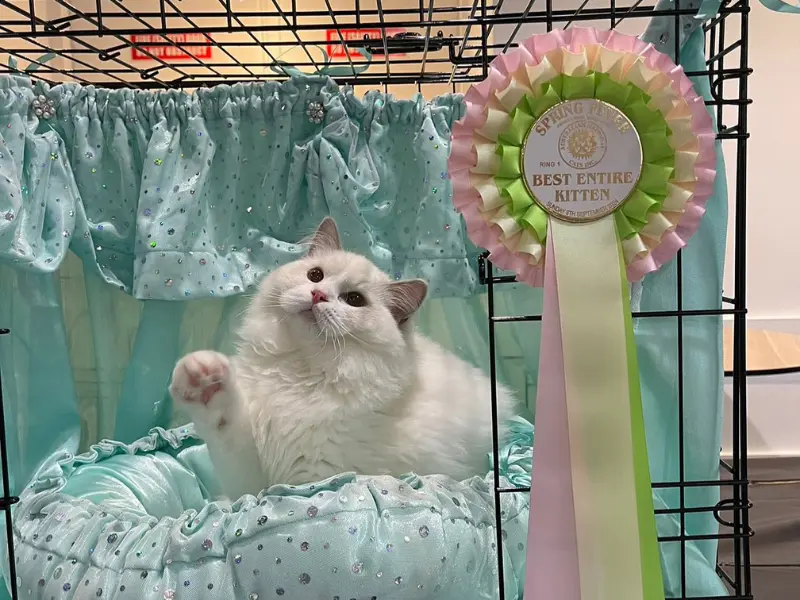
A True Family Cat
Our Lilac Bicolor Ragdolls love being part of the family action. Whether we are watching TV, cooking dinner or even folding laundry, they always want to be nearby. They are happiest when included in our routines and we have noticed they form strong bonds with every member of the household.
Good with Kids and Other Pets
One of the things we treasure most about this breed is how patient and gentle they are. Our lilac fluffballs don’t mind being picked up (and flopped like the true Ragdolls they are) and they usually get along wonderfully with kids, other cats and even dogs. They seem to have a calming presence that blends beautifully into multi-pet homes.
Daily Routines with a Lilac Cuddle Buddy
Living with a Lilac Bicolor means plenty of cozy rituals:
- Morning greetings: Ours often hop onto the bed to purr us awake.
- Workday companions: They will lounge by our desks or nap in sunbeams while we work.
- Evening cuddles: After playtime, they settle in for a quiet snuggle session on the couch.
They don’t need constant entertainment but they do enjoy interactive toys and a good play session each day to keep them healthy and engaged.
The Balance of Play and Calm
What we love most is their balance. They are playful without being wild and affectionate without being clingy. They will happily chase a feather wand for 15 minutes, then flop into our laps for a long nap. Their calm nature makes life with them feel relaxed and full of love.
What to Expect in the Long Run
Ragdolls are a large breed that matures slowly, so be prepared for a kitten who keeps growing and developing for years. Our lilacs reached their full size and coat beauty around 3–4 years old. Every stage was a joy from fluffy kitten antics to their full majestic adult selves.
Living with a Lilac Bicolor Ragdoll truly means having a best friend who’s always ready for cuddles, play, or just quiet company. They bring warmth to the home in ways only a gentle fluffball can.
Are Lilac Bicolor Ragdolls Rare?
One of the questions we hear most often is, “Are Lilac Bicolor Ragdolls really that rare?” The short answer is yes and that’s part of what makes them so special. 💜
Why Are They Rare?
Lilac Bicolors are considered one of the rarest Ragdoll color variations. The reason comes down to genetics. The “lilac” shade is actually a diluted version of chocolate which means both parents must carry the right genes for a kitten to be born lilac. On top of that, to get the bicolor pattern (with that snowy white inverted “V”), specific coat pattern genes also need to be passed along.
So, not only does the kitten need the lilac color gene but it also needs the bicolor pattern gene making this combination less common than other shades like seal or blue point ragdolls.
Breeding Combinations
To produce lilac bicolor kittens, breeders often pair cats with chocolate or lilac coloring. Even then, not every kitten in the litter will turn out lilac bicolor. Sometimes you will see seal, blue, chocolate or mitted variations instead. It’s a bit like nature rolling the dice with every litter.
What This Means for Cat Lovers
Because they are so rare, Lilac Bicolor Ragdolls may be harder to find and when you do find them, they are often reserved quickly. Many reputable breeders keep waiting lists for lilac kittens, so patience is key if your heart is set on one.
Are They Worth the Wait?
Absolutely. Their soft, pastel coats paired with those blue eyes make them look like living works of art. And since their personalities are just as sweet as any Ragdoll, you get both beauty and love in one floppy package.
We always say that finding a Lilac Bicolor Ragdoll is like discovering a hidden gem which is rare, precious and unforgettable. ✨
Conclusion
Living with a Lilac Bicolor Ragdoll is truly like sharing your home with a little piece of magic. From their pastel coats and sparkling blue eyes to their gentle nature, these cats are the perfect mix of beauty and sweetness.
We have seen how they brighten daily life, whether they are greeting us with a soft purr in the morning, keeping us company during the day or curling up for a cuddle at night. Their calm and affectionate personalities make them wonderful companions for families, kids and even other pets.
Yes, they are rare. Yes, they can be a little more expensive. But every moment with a Lilac Bicolor Ragdoll reminds us that they are worth the wait, the care and the investment of love. They are more than pets, they are family, and they give back endless affection in return.
If you are dreaming about welcoming one of these pastel beauties into your life, we say go for it! Just be ready for a lifetime of purrs, flops and heart melting blue eyed gazes. 🐾
So tell us, can you picture a Lilac Bicolor Ragdoll curled up on your lap right now? Because we sure can.
FAQs About Lilac Bicolor Ragdolls
Here is the list of frequently asked questions:
A Lilac Bicolor Ragdoll is a rare color variation of the Ragdoll breed. Their coat combines snowy white areas with soft lilac shading, plus a sweet inverted “V” mask on the face. They also have the breed’s famous blue eyes and cuddling personality.
Yes, Lilac Bicolor Ragdolls are considered rare because both the lilac color gene and the bicolor pattern gene need to be present. This makes them less common than seal or blue Ragdolls, which are easier to find.
No, their personality is just as loving, gentle and floppy as any other Ragdoll. The only difference is their coat color and markings. Lilac Bicolors are known for being affectionate, calm and wonderful family companions.
On average, Lilac Bicolor Ragdoll kittens cost between $1,200 and $3,000 USD. The price depends on factors like rarity, breeder reputation, bloodline and whether the kitten is pet quality or show quality.
Lilac Bicolor Ragdoll kittens are born mostly white. As they grow, their lilac-gray shading appears on the ears, tail and back while the white inverted “V” on their face and snowy paws remain. Their sky blue eyes develop early and stay for life.
Their silky coat requires low maintenance as compared to many long-haired cats. Brushing a few times a week helps prevent tangles and keeps the fur shiny. Regular nail trims, eye wipes if needed and a healthy diet also help them look and feel their best.
Yes, Lilac Bicolor Ragdolls are very social and gentle. They usually get along well with kids, other cats and even dogs. Their calm and patient nature makes them excellent family cats.

- Be Respectful
- Stay Relevant
- Stay Positive
- True Feedback
- Encourage Discussion
- Avoid Spamming
- No Fake News
- Don't Copy-Paste
- No Personal Attacks



- Be Respectful
- Stay Relevant
- Stay Positive
- True Feedback
- Encourage Discussion
- Avoid Spamming
- No Fake News
- Don't Copy-Paste
- No Personal Attacks


